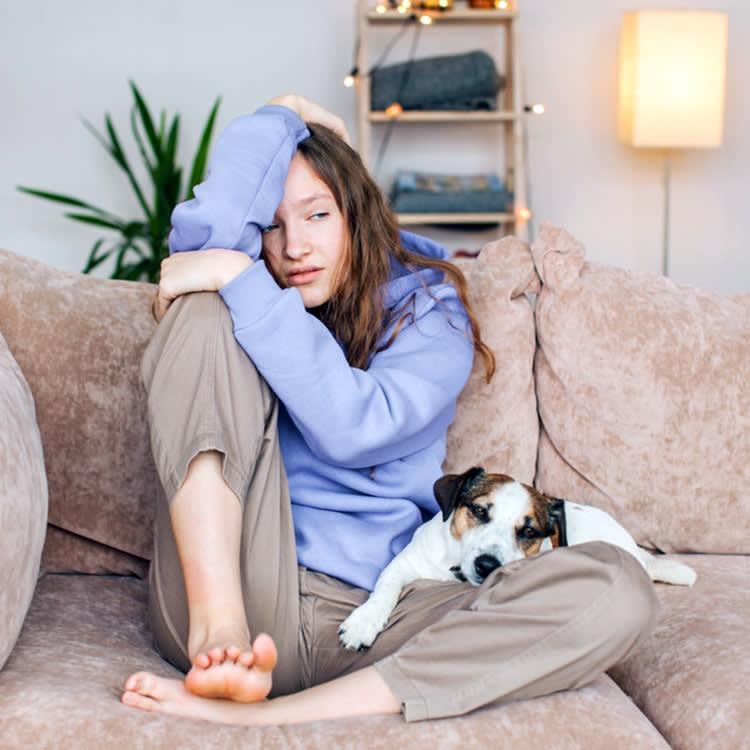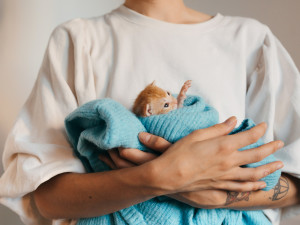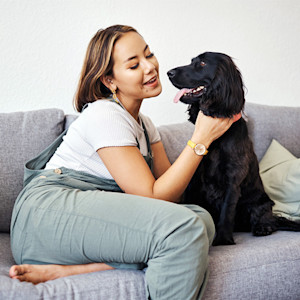How to Deal With the Chaos of New Pet Parenthood
It’s a lot of responsibility, but it’s worth it.

Share Article
It’s called pet “parenthood” for a reason; when you bring home a pet, you truly become a parent, with all of the responsibility that entails. From figuring out what (and when) to feed your pet, how to approach all kinds of training, and beyond, the first few weeks of pet parenthood are typically packed with decisions and new scenarios that can feel chaotic. And that’s not even taking into account your new pet’s behavior, which can cause a whole new kind of bedlam.
So, what can you do to deal with all that wild change? We’ve got some ideas.
Prepare ahead of time.
The best thing you can do to minimize the madness (at least from a medical perspective) is to anticipate it the best you can, according to Dr. Lindsey Wendt, founder of Crystal Lotus Veterinary Careopens in new tab.
One of the most common issues pets face? Upset stomachs. Whether due to the stress of adapting to a new environment or transitioning to new food, many pets experience GI upset. Dr. Wendt says new pet parents can preemptively avoid this problem (or at least help) by giving their new pet a digestive enzyme or probiotic with their food r ight away.

Another immediate, preventative step new pet parents can take? Visit their vet immediately, and bring a stool sample for a fecal test to determine if your new pet has fecal parasites. Hopefully, getting ahead of this will keep pet parents from having to decontaminate their homes. Plus, Dr. Wendt says, if you have another dog or cat, “you don’t want them to be exposed and then infected by the new one coming into the household.”
Finally, new pet parents should look into pet insurance as soon as possible. Research pet insurance policies before bringing home your new pet, Wendt says, so you “know whether or not you need an exam and what steps are required to activate the insurance.” Some policies might include a waiting period, so you’ll want to get the process started as soon as possible, in case any medical issues come up early into your pet’s time with you.
Beyond the turmoil of upset stomachs or other medical issues, many new pet parents experience behavioral issues, which can vary based on a number of factors, including your new pet’s age and background.
What should you expect when adopting a puppy or kitten?
One of the biggest challenges puppy parents have, according to Karishma Warr, Calm Canine Academy’s head of behavioropens in new tab, “is underestimating [a puppy] is like an actual human infant.” As with any infant, parents will need to make accommodations.
“Lots of people expect [a new] puppy to fit into their house, but that’s not how it works with an infant,” Warr points out. “Just like we would cover the edges of tables and plug sockets [for infants], we know [that puppies are] going to do things we don’t want them to do.” New parents should adjust their environment to meet a puppy’s needs and safety, just like they would for a child, rather than expecting their puppy to adjust to their environment.
But while an environment is relatively controllable, your puppy ultimately is not — at least not right away. A big reason why: Most dog parents don’t know how to communicate with their cute new family members.
So much mayhem happens when “puppies are trying to communicate something to the guardians, and they’re not getting it, and the humans are trying to communicate something to the puppy, and they’re not getting it,” Warr says.
One of the biggest miscommunications that occurs between puppies and new pet parents is when parents fail to meet their puppy’s needs. When puppies misbehave — when they chew furniture or have accidents — they are doing so because their needs haven’t been met. Per Warr, it’s essential to have a routine that “preemptively meets [a puppy’s] needs so that they’re not having to seek out those needs being met in ways we don’t like.” For example, if this schedule accommodates their potty breaks, play-time requirements, etc., they will be less likely to tear a hole in your favorite blanket.
At the risk of stating the obvious, that communication disconnect between people and pets is normal; humans aren’t born being able to talk to animals, with the exception of the (fictional) Dr. Doolittle and maybe Jane Goodall. But many people have devoted time and research to figuring out how; new pet parents should feel no shame about relying on those experts. Bringing in a trainer or behavioral consultant early in your relationship with your new pet can help you overall ability to communicate with them.
Another big one: Give puppies time in nature if possible. “Getting young puppies out into clean, natural environments if they’re accessible to you” is “something I seek out actively for puppies in my care, and I see amazing benefits for doing something like that,” Warr says. “They’ll sleep better, they’ll be less mouthy, they’ll have better social skills.”
And if you’ve tried all that, and your puppy is still having accidents, biting everything, and generally wreaking havoc? Let go of perfectionism, and wait it out. Remember, setbacks are normal, and so is what trainers call “the puppy blues,” aka new-pet-parent depression. (Don’t worry; it gets better!)
“I see parents striving for perfectionism, worried that their dog had an accident in the house,” Warr says. “Do you know how many accidents I cleaned up with my dogs? And they’re perfectly potty trained now.”
Ultimately, Warr concludes, “trust the process, take it easy, and focus on having fun with [your puppy].”
The key to managing kitten chaos may be a little different, though. Many experts recommend adopting more than one kitten to avoid “single-kitten syndrome.” If your kitten is misbehaving or getting into trouble, getting them a brother or sister can help keep them occupied and out of trouble, thanks to the physical and mental exercise, socialization, and comfort a sibling can offer.
If adopting another kitten isn’t an option, make sure your cat is experiencing enrichment, including socialization (which is critical to their development at a young age), play time, and training. (Yes, you can train a cat!)
What to expect when adopting a rescue pet
Pet parents of rescued pets, especially adolescents or adults, may have a whole different kind of adjustment period. But the first step any parent in this situation should take is the same: Give your new pet some space.
As behaviorist Lindsay Hamrick wrote for Kinship, “all cats benefit from initially having their own, personal space they can retreat to as they slowly acclimate to the smells, sights, and sounds of their new environment.” This can be true for the first days — or even weeks — in their new home. Then, let your new cat come to you and reward their curiosity when they do with a treat (or many).
Dogs similarly often need a decompression period, commonly referred to as “the rule of threes”: Most rescue dogs need three days to adjust to their new surroundings, three weeks to settle in, and then three months to build trust and bond with their new family members.
Warr says it may even take up to six months for some dogs to fully settle into a family, because “even dogs who don’t come from capital ‘T’ traumatizing scenarios” but whose “needs were not met chronically,” can be traumatized. Pet parents should expect that their behavior might change over time.
In the meantime, pet parents can make their pets feel as comfortable as possible by “shielding them from doing and seeing too many new things.” While our first instinct may be to introduce a new dog to every aspect of their new life — including parks, family members, and friends — the first few days and weeks especially are “not the time for it,” Warr says. “You have to treat [rescue dogs] like they’ve come back from war because they have if they come out of shelters or rescue systems.”
Instead, pet parents need to think of themselves as “being a safe landing place for [your dog], rather than just thinking of [your dog] as a way to have fun or meet your needs; you’re going to have to think about them for a little bit and take it slow.”
Of course, there is a line between normal acclimation and aggressive behavior. First and foremost, Warr says, pet parents should “prioritize safety for everyone, especially dogs and children, and dogs with other dogs.” So, when introducing a new rescue pet into the home, it’s wise to “be cautious, take it slow, not [leave your new pet] unsupervised” at first.
If your rescue pet continues to exhibit excessive “lunging, barking, extreme fear responses, shaking, howling,” or other worrying behaviors, Warr says it’s likely worth bringing in a trainer or behavioral consultant.
“If people are feeling overwhelmed, one of the best things you can do is get external eyes on the situation,” Warr says. “Having someone else guide you, to steer the ship, who can see the forest through the trees and who has done this a hundred dogs before with a hundred different people who have a very similar situation to you — that can be really important.”

Julie Zeilinger
Julie Zeilinger is a writer and editor whose writing has been published in Marie Claire, Forbes, Vox, HuffPost, and other publications. She is also the author of two books: College 101: A Girl’s Guide to Freshman Year (2014) and A Little F’d Up: Why Feminism Is Not a Dirty Word (2012). She has a two-year-old Bichpoo named Baloo and is a foster mom to dogs via Badass Animal Rescue.
Related articles
![Woman In Sportswear Walking With Two Dogs On The Street.]()
What’s Stopping You From Fostering a Pet?
Here are six very good reasons why you should reconsider.
![Stray dog sleeping on the street]()
Four Things to Do If You Want to Adopt a Dog From Another Country
Fall in love abroad? Follow these simple steps to bring your new family member home.
![anonymous woman pampering and taking care about a small ginger kitten]()
6 Ways to Help Local Shelters Without Committing to Full-Time Pet Parenthood
Learn how you can be there for animals in need this National Pet Day.
![Woman sitting on couch, frustrated with her small dog.]()
The “Puppy Blues” Are a Struggle for About Half of New Dog Parents, Study Finds
If you’re feeling stressed or sad after bringing home a young pup, you’re not alone.
![Couple hug their Pit Bull dog outside on the beach.]()
How to Help the Rescue Pets Who Seem to Be Stuck at Shelters Forever
And why the problem of long-term rescue and foster animals persists.
![Woman with dog in home on sofa, relaxing and playing.]()
Fostering a Dog for Even a Couple Days Increases Their Chances of Adoption, Study Says
Even a small amount of quality time makes a huge difference to shelter pups.








